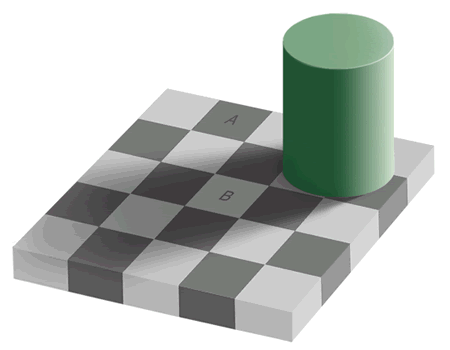Compare the Squares
Have a look at this picture of a chessboard. There is a cylinder placed on the board which is casting a shadow:

Look at the squares marked A and B.
Do you think they are the same colour or different colours?
Show this image to some other people. Perhaps you could ask other children in your class, or members of your family.
What do they think? Are the squares the same colour or different colours?
Keep a record of how many people think they are the same and how many think they're different.
When you've asked, say, 10 people (you might be able to ask more), have a look at your results.
What percentage of people you asked thought they were the same?
What percentage thought they were different?
Now, have a look at this
picture . (It will open in a new window.)
This new image shows the same chessboard and cylinder, but now the squares A and B are joined by two strips which are the same colour at all points.
What do you think now? Are squares A and B the same colour as each other or not?
Show this new picture to the same people you showed the first one to.
What do they think? Are the two squares the same colour or different colours?
Do any of them change their mind compared with their first answer?
What percentage think they are the same now?
If you look at this second set of data you've collected, does it persuade you to change your mind?
How could you convince yourself and others that the squares are the same colour or not?
The optical illusion in this problem creates a good opportunity for children to conduct an opinion poll. If each of them asks ten people outside school then you might decide to pool everyone's data and create a large sample, although this is not necessary at all - it depends on your focus. You might decide to place more emphasis on how the data is displayed.
What might be more interesting is to show just the second picture to a group of people who haven't seen the first and to see whether they immediately say the squares are the same colour. Alternatively, it might be interesting to show the first picture to a group and tell them the proportion of people who'd seen both images who thought the squares were the same colour to see whether they are
influenced in any way by the statistics!
gives more information about the illusion and possible proofs.
